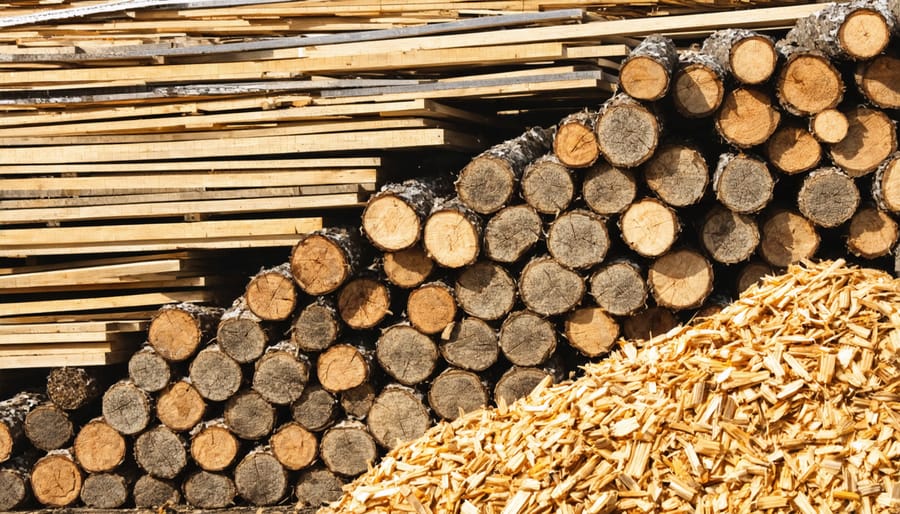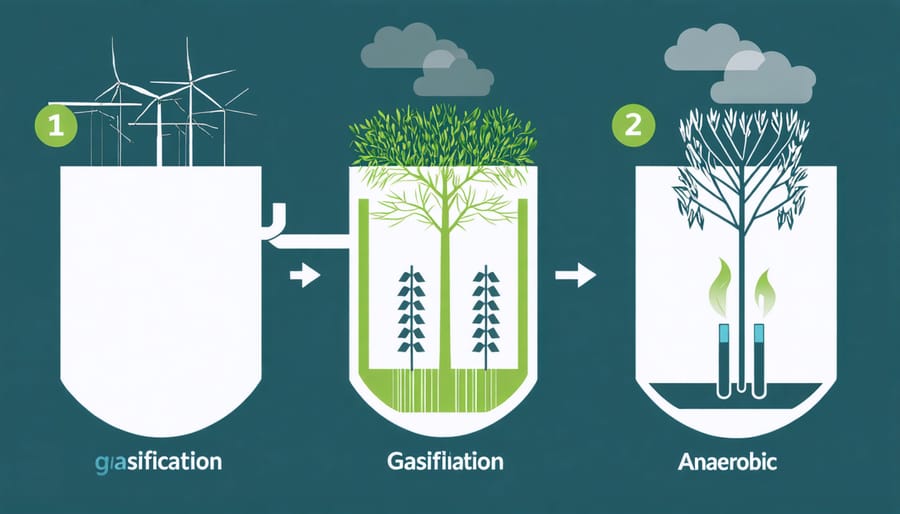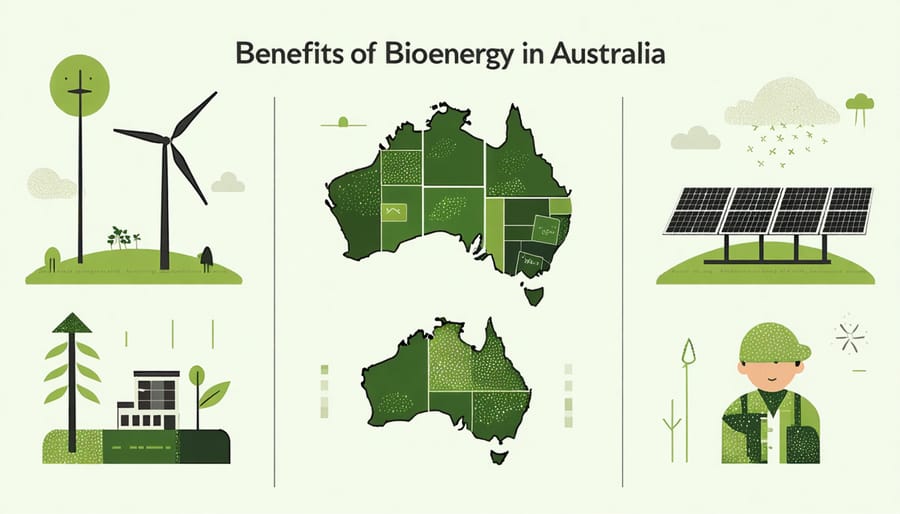Harness the power of bioenergy and biomass to fuel a sustainable future for Australia. Bioenergy, derived from organic matter, offers a renewable, low-carbon alternative to fossil fuels. By converting agricultural waste, forestry residues, and dedicated energy crops into electricity, heat, and biofuels, we can reduce greenhouse gas emissions and enhance energy security. Why bioenergy is important lies in its potential to create jobs, stimulate regional economies, and contribute to Australia’s net-zero emissions target. With vast land resources and a thriving agricultural sector, Australia is poised to become a global leader in sustainable bioenergy production. Embracing this opportunity will not only help combat climate change but also drive innovation and resilience in our energy landscape. The time to act is now – let us work together to unlock the full potential of bioenergy and build a cleaner, greener future for generations to come.
What is Bioenergy and How Does it Work?
Types of Biomass
Biomass feedstocks, the organic materials used to generate bioenergy, come in a variety of forms. Agricultural waste, such as sugarcane bagasse, wheat straw, and corn stover, is a significant source of biomass in Australia. These residues from crop harvesting and processing can be converted into energy rather than being discarded. Forestry byproducts, including wood chips, sawdust, and logging residues, also serve as valuable biomass resources. Australia’s extensive timber industry generates substantial quantities of these materials, which can be sustainably harvested and utilized for bioenergy production.
Energy crops, specifically grown for their high biomass yield, are another promising feedstock. Species such as switchgrass, miscanthus, and short-rotation eucalyptus plantations can be cultivated on marginal lands unsuitable for food production. These dedicated energy crops have the potential to provide a reliable, renewable source of biomass without competing with food supply. Additionally, urban waste streams, including food waste, garden trimmings, and even sewage sludge, can be harnessed as biomass feedstocks. By diverting these materials from landfills and converting them into energy, we can reduce greenhouse gas emissions and create a more circular economy. The diversity of biomass sources available in Australia highlights the immense potential for bioenergy to contribute to our sustainable energy future.

Conversion Technologies
Biomass can be converted into energy through various methods, each with its own advantages. Combustion is the most common technique, involving burning organic materials to produce heat and electricity. This process is well-suited for large-scale power generation and can utilize a wide range of feedstocks. Gasification is another promising approach, which converts biomass into a combustible gas mixture called syngas. This versatile fuel can be used for heat, power, or even transformed into liquid biofuels. Anaerobic digestion is a biological process that breaks down organic matter in the absence of oxygen, producing biogas rich in methane. This method is particularly effective for managing wet biomass, such as agricultural waste and sewage sludge. Pyrolysis is a thermochemical process that heats biomass in the absence of oxygen, yielding bio-oil, syngas, and biochar. These products have diverse applications, from energy generation to soil enhancement. By leveraging these conversion technologies, Australia can harness its abundant biomass resources to create clean, renewable energy while reducing waste and greenhouse gas emissions. As research and innovation continue to advance, the efficiency and sustainability of these processes will only improve, making bioenergy an increasingly viable solution for the nation’s energy needs.


Benefits of Bioenergy for Australia
Reducing Greenhouse Gas Emissions
Bioenergy can play a crucial role in helping Australia meet its ambitious carbon reduction targets and mitigate the impacts of climate change. By harnessing the power of organic matter, such as agricultural waste, forestry residues, and purpose-grown crops, bioenergy offers a renewable and sustainable alternative to fossil fuels. As Australia aims to reduce its greenhouse gas emissions by 43% below 2005 levels by 2030, bioenergy presents a promising pathway to fueling Australia’s sustainable future.
When biomass is utilized for energy production, it releases the same amount of carbon dioxide that was absorbed by the plants during their growth. This creates a closed-loop carbon cycle, making bioenergy a carbon-neutral solution. By displacing fossil fuels in industries such as electricity generation, heating, and transportation, bioenergy can significantly reduce Australia’s carbon footprint. Moreover, the use of agricultural and forestry waste for bioenergy production helps to minimize methane emissions from decomposing organic matter, further contributing to greenhouse gas reduction efforts.
Investing in bioenergy not only supports Australia’s climate change mitigation goals but also stimulates economic growth and creates new job opportunities in rural and regional areas. As the country transitions towards a more sustainable future, bioenergy will undoubtedly play a vital role in achieving a low-carbon economy.
Enhancing Energy Security
Australia has a tremendous opportunity to enhance its energy security by harnessing the power of domestic biomass resources. By leveraging the country’s vast agricultural and forestry waste, as well as dedicated energy crops, Australia can reduce its reliance on imported fossil fuels and increase its energy independence. Bioenergy production from local feedstocks not only diversifies the nation’s energy mix but also creates jobs and supports regional economies.
Moreover, using domestic biomass for energy generation helps to mitigate the risks associated with global supply chain disruptions and price volatility in the fossil fuel market. By investing in bioenergy infrastructure and technologies, Australia can build a more resilient and self-sufficient energy system that is less vulnerable to external shocks. This increased energy security will provide a stable foundation for sustainable economic growth and help Australia meet its climate change commitments while ensuring a reliable and affordable energy supply for its citizens.
Creating Green Jobs
The development of Australia’s bioenergy sector has the potential to create a significant number of green jobs, particularly in regional and rural areas. As demand for sustainable energy solutions grows, bioenergy projects can stimulate economic growth and provide new employment opportunities across various sectors, from agriculture and forestry to engineering and construction. Farmers and landowners can benefit from additional income streams by supplying biomass feedstocks, while skilled workers will be needed to design, build, and operate bioenergy facilities. These jobs often require specialized training, creating opportunities for education and upskilling in local communities.
Moreover, the growth of the bioenergy industry can have a multiplier effect on job creation, as it supports a wide range of ancillary services and businesses, such as equipment manufacturers, transport companies, and maintenance providers. By investing in bioenergy projects, Australia can not only reduce its carbon footprint but also foster a thriving green economy that benefits both the environment and the livelihoods of its citizens. As the world transitions to a low-carbon future, embracing bioenergy can help position Australia as a leader in sustainable energy solutions while creating meaningful employment opportunities for its workforce.
Applications of Bioenergy in Australia
Powering Homes and Businesses
Australia is leading the way in harnessing the power of biomass for heating and electricity in homes and businesses. In Victoria, a family-owned timber mill has successfully integrated biomass energy into their operations, utilizing wood waste to generate heat and power for their facilities. This not only reduces their reliance on fossil fuels but also minimizes waste and greenhouse gas emissions.
Meanwhile, in Western Australia, a pioneering bioenergy plant is transforming agricultural waste into clean, renewable energy for local households and businesses. By partnering with nearby farms, the plant sources sustainable biomass feedstock, supporting the regional economy while providing a reliable, low-carbon energy solution.
These success stories demonstrate the practical applications and benefits of bioenergy in the Australian context. As more households and companies embrace biomass energy solutions, they are not only reducing their environmental impact but also contributing to a more resilient and self-sufficient energy future for the nation. With the right policies and investments, Australia has the potential to become a global leader in sustainable bioenergy, powering homes and businesses while protecting the planet for generations to come.
Fueling Transportation
Bioenergy and biomass offer exciting potential for fueling the transportation sector and reducing emissions from vehicles. By producing biofuels derived from organic matter, such as plants and agricultural waste, we can create a sustainable alternative to fossil fuels. These biofuels, including bioethanol and biodiesel, can be used in existing vehicles with minimal modifications, making the transition to cleaner energy more feasible.
In Australia, the adoption of biofuels in transportation could significantly contribute to meeting our emissions reduction targets. By blending biofuels with traditional petrol and diesel, we can lower the carbon footprint of our vehicles without compromising performance. Furthermore, the production of biofuels from local biomass sources can support regional economies and create new job opportunities in rural areas.
As technology advances, the efficiency and sustainability of biofuel production continue to improve. Innovative processes are being developed to convert a wider range of biomass feedstocks into high-quality fuels, while minimizing land use impacts and ensuring food security. By investing in research and infrastructure, Australia can position itself as a leader in the global shift towards cleaner, greener transportation powered by bioenergy.
Conclusion
In conclusion, bioenergy and biomass offer a promising path towards a sustainable future for Australia. By harnessing the power of renewable organic materials, we can reduce our reliance on fossil fuels, lower greenhouse gas emissions, and stimulate economic growth in regional areas. The diverse range of biomass sources available in Australia, from agricultural waste to dedicated energy crops, provides ample opportunities for the development of a thriving bioenergy industry.
As we have seen, bioenergy projects are already making a positive impact across the country, from the innovative use of sugarcane waste in Queensland to the production of renewable gas from household rubbish in Western Australia. These success stories demonstrate the practical applications and benefits of bioenergy, and serve as an inspiration for further investment and research in this field.
However, to fully realize the potential of bioenergy and biomass, we need the support and commitment of all Australians. By embracing sustainable energy solutions, we can create a cleaner, greener, and more prosperous future for generations to come. We call on individuals, organizations, and policymakers to join us in championing the growth of bioenergy initiatives across the nation. Together, we can build a stronger, more resilient Australia powered by renewable energy.

